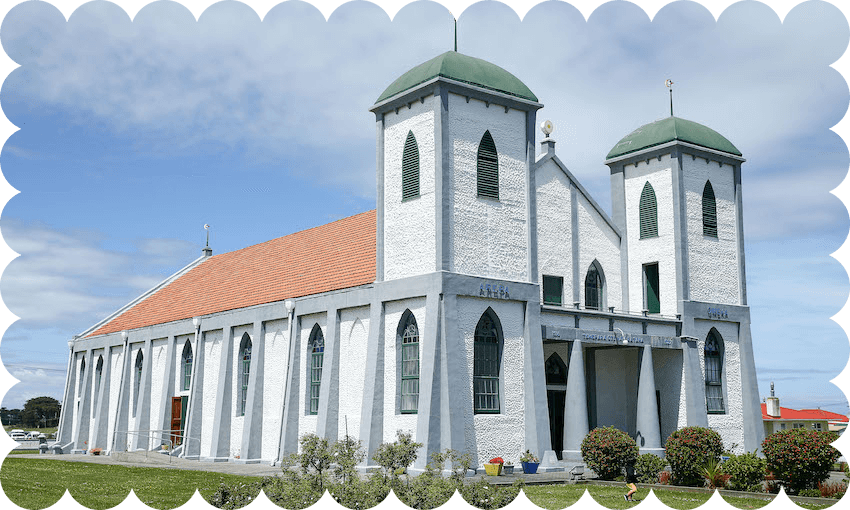The event has tried to steer clear of politics in recent years, but after te hui aa motu, that goal is looking impossible for 2024.
Te hui aa motu was not the only important political event happening in te ao Māori in early 2024. Alongside what is shaping up to be the most significant Waitangi Day in quite some time, the special annual hui at the Rātana church’s pā near Whanganui is happening this week. So what is the yearly hui, and will this year’s iteration differ from previous instalments?
What is the Rātana Church?
This hāhi, named after its founder Tahupotiki Wiremu Rātana, who started the church in 1918, is the biggest hybrid Māori-Christian faith. It has more followers, called mōrehu, than older hybrid denominations like Pai Mārire and Ringatū. Census data from 2018 recorded 43,821 mōrehu, more than the combined followership of Pai Mārire and Ringatū (13,530). Rātana is our eighth-biggest Christian denomination, bigger than the Baptist church, for example.
Although its pā is on TW Rātana’s whānau farm 20km south of Whanganui, it has followers across the motu and over the ditch. There’s a particularly powerful presence in Te Tai Tokerau and there are also parishes in Australia.
Why is this church politically relevant?
Rātana has the most esteemed political legacy of any New Zealand church. TW Rātana did not hide his denomination’s political ambitions, using his platform to advocate for Te Tiriti o Waitangi and mana motuhake. At the same time, his hāhi’s political wing, Koata, sought parliamentary power. While its first MP was elected in 1932, the church’s political peak was from 1943 into the 1990s when every Māori seat MP was either a mōrehu or Rātana endorsee. Its first MP was Eruera Tirikatene, whose whānau dynastically controlled the southern Māori/Te Tai Tonga electorate for 72 of the last 91 years. Since Rātana stopped officially fielding parliamentary candidates in the 1990s, many mōrehu have become MPs anyway – like former speaker of the house Adrian Rurawhe, TW Rātana’s grandson. Rurawhe and his cousin Soraya Peke-Mason are the modern personifications of the long-lasting Labour-Rātana alliance.
What’s happening this week at Rātana pā?
Annually, the church hosts a significant political event that lasts several days over the week of January 25. On January 24, politicians travel to Rātana pā to hear from and speak to Māori leaders. Last year’s celebration marked the final outing of Jacinda Ardern’s prime ministership, symbolising the strong Labour-Rātana relationship. Despite Rātana trying to downplay the political nature of its hui recently, this year will be particularly politicised (more on that later).
What’s important about January 25?
This date marks the birthday of TW Rātana. He was born in 1873, meaning that Ardern’s farewell happened the day before his birth’s 150th anniversary.
Who will be there?
Aside from Rātana faithful and iwi Māori, the hāhi’s annual hui is typically attended by politicians – not just from Labour but from parliament at large. The government will be represented by a National Party contingent led by prime minister Christopher Luxon and Tama Potaka (minister for Māori-Crown relations, Māori development and whānau ora), joined by New Zealand First MPs Winston Peters, Shane Jones, Casey Costello and Jenny Marcroft. The Act Party has confirmed its representatives will not attend Rātana.
Parliament’s opposition parties, the Greens, Labour and Te Pāti Māori, will be well represented at Rātana. Another significant attendee will be te Kiingitanga leader Tuheitia, who will play a particularly important role.
Will this year be any different from usual?
In the face of what looks to be the most united tāngata whenua opposition to government policy in two decades, this year’s Rātana will feel very different to years past as the event returns to the overt politicisation Rātana has recently tried to shun in favour of celebrating the birth of TW Rātana. The presence of Kiingi Tuheitia is paramount, as he will present the conclusions of te hui aa motu to the nation at Rātana pā. Kiingi Tuheitia and representatives of te Kiingitanga will arrive today, joined by Te Pāti Māori. According to a press release from Te Pāti Māori, “This is the first time in the history of Rātana that a political party has broken away from tradition of attending with other parties, and the first time a political party has attended alongside the Kiingitanga – symbolic of kotahitanga and unity as te iwi Māori.”
What’s the vibe?
As mentioned, this year’s event at Rātana pā will be particularly politically charged. Since this is only the second of three early 2024 Māori political events, expect Rātana, like te hui aa motu before it, to inspire further mahi onwards towards Waitangi Day. As you’d expect at a hāhi, the vibe at Rātana will be more serious and less the full-on family festival atmosphere that Waitangi is known for and that te hui aa motu dipped its toes into. But tamariki are still welcome, and the church will provide activities to keep them busy.
So what exactly is happening on Wednesday and Thursday?
At 9am on Thursday, the pōwhiri begins and includes an address from Andre Mason, the tumuaki of the Whanganui-based Rātana hāhi. The main event starts at midday, so if you’re keen to see the continuation of the kaupapa started at te hui aa motu, tune in to news coverage and live streams from 12pm. MPs have a chance to address the nation on Wednesday, and politicking often ensues. Last year, now prime minister Christopher Luxon used his speaking slot to oppose co-governance. Given that race relations has been the political flavour of the month to start 2024, expect fireworks from the speakers at Rātana this week.
This is Public Interest Journalism funded by NZ On Air.





